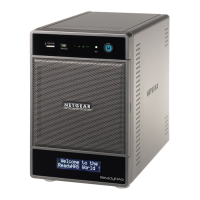Shares
33
ReadyNAS for Home RAIDiator 4.2
File-Sharing Protocols
Shares can be accessed over a network. Network access to data stored on your ReadyNAS
system is managed by file-sharing protocols, which handle the transfer of data. You can
access a share on your ReadyNAS from other network-attached devices (for example, a
laptop or a tablet) if the share is enabled for a file-sharing protocol that the network-attached
device supports. You can enable a share to support more than one fire-sharing protocol.
Table 2 lists the file-sharing protocols that your ReadyNAS storage system supports.
Table 2. Supported file-sharing protocols
Protocol Description Recommendation
CIFS
(Common Internet
File Service)
Used mainly by Microsoft Windows
computers and sometimes by Mac OS X
computers, this protocol is enabled by
default. It is sometimes referred to as the
SMB (Server Message Block)
file-sharing protocol.
If Windows users will access your
storage system, enable this protocol.
NFS
(Network File
Service)
Used by Linux and Unix computers. Your
ReadyNAS system supports NFS v3
over UDP and TCP.
If Linux or Unix users will access your
storage system, enable this protocol.
AFP
(Apple File Protocol)
Used by Mac OS 9 and Mac OS X
computers. Your ReadyNAS system
supports AFP 3.2.
If only Mac OS 9 and OS X users will
access this your storage system,
enable this protocol. However, in a
mixed Windows and Mac
environment, NETGEAR
recommends using CIFS only.
FTP
(File Transfer
Protocol) and
FTPS
(FTP with SSL
encryption)
Used by many public file upload and
download sites.
If users will access your storage
system using FTP, enable this
protocol.
HTTP
(Hypertext Transfer
Protocol and
HTTPS
(HTTP with SSL
encryption)
Used on the world wide web. If users will access your storage
system from a device with a web
browser, including a smart phone or
tablet computer, enable this protocol.
Rsync Fast file-transfer protocol that uses a
delta-transfer algorithm that sends only
the differences between the source file
and the existing file.
If users will access your storage
system from a device that supports
Rsync, enable this protocol.
When users access a share, it appears in their computer like a hard disk, and users can
interact with it like they interact with a hard disk, depending on the access rights that are
granted to the share and protocol combination.

